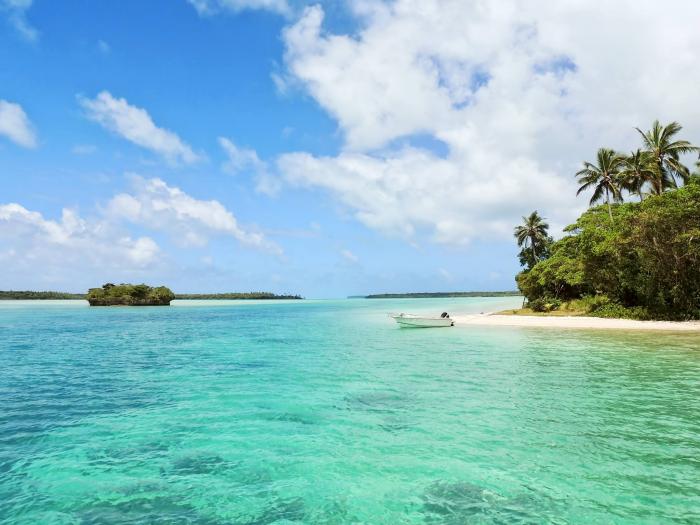
Island facts
New Caledonia is a French territory made up of a group of islands and archipelagoes of Oceania, located in the Coral Sea and the South Pacific Ocean. It has a wide lagoon often considered "the most beautiful lagoon in the world". The territory is also distinguished by biodiversity of astonishing richness and originality: the rate of endemic species is the highest in the world.
New Caledonia's economy is one of the most dynamic in French overseas territories, which is particularly related to underground resources: New Caledonia holds between 20% and 30% of the world's known nickel reserves.
High productivity = high dependence?
New Caledonia is currently highly dependent on imports of high-carbon energy sources for its energy supply. 97,5% of the island’s energy needs are covered by imports of coal and petroleum products such as gasoline, diesel, gas (LPG), kerosene and heavy fuel oil. The top 3 energy-consuming sectors are industry (53,6% including mining and metallurgy), transportation (22,6%) and the residential/tertiary sector (7,5%).
The dependence and size of New Caledonia’s market compared to larger countries in the Asia-Pacific zone makes the island very vulnerable in terms of energy supply – an unnecessary level of dependence considering the local renewable resources that could be exploited on the island.
An energy transition could hence help New Caledonia reduce its energy dependence, ensure the security of supply, guarantee a competitive energy price, and reduce the impacts on the environment and the planet.
A change is coming
As a country of Oceania, one of the parts of the world most impacted by climate change, New Caledonia wishes to be exemplary in terms of energy policy.
Building on the Paris Agreement, the Congress of New Caledonia adopted the Energetic Transition Scheme of New Caledonia (STENC) in June 2016. The scheme has three main objectives for 2030:
- Reduction of the energy consumption by 20% for primary energy and 25% for final consumption;
- Reduction of the CO2 emissions by 35% in the residential and tertiary sector, 10% in mining and metallurgy, 15% in the transport sector;
- Development of renewable energies to reach 100% of the consumption of the public distribution of electrical energy and 100% of electrical energy on the smaller islands of the archipelago.
Since the adoption of the STENC, a certain number of actions have already been put in place, but much remains to be done.
In the transport sector, the development of company movements plans, the promotion of eco-mobility and the introduction of eco-driving training have helped to raise awareness among the population. However, no regulation exists in terms of energy efficiency in transport (no technical inspection of vehicles, no import standards ...). At the industry level, the economic context of recent years has not been conducive to the implementation of energy control measures, which often requires a relatively large initial investment. Finally, with regard to the residential/tertiary sector, a regulation on the energy efficiency of equipment voted in December 2018 by the New Caledonia Congress confirmed the approach taken towards energy efficiency (the obligation to affix an energy label, prohibition of imports of incandescent and halogen bulbs and prohibition of import of equipment containing substances depleting the ozone layer). Nevertheless, despite several proposals, no energy regulation of buildings could be put in place to date, for lack of agreement with the professionals.
The objective of the development of renewable energies set in the STENC is to achieve a renewable electricity production equivalent to the electricity consumption of the public distribution by 2030. To achieve this goal, the government in 2016 set the multi-year programming of electricity generation investments (see table below).

Regarding the photovoltaic sector, the target set for 2020 was reached in 2018. To not slow down the development of this sector, the government has increased the objective in its multiannual investment programming. This new goal was achieved in 2019. A number of renewable energy projects have been authorised in this context, including solar roof systems. A wind farm of 20MW is currently under construction in Yaté (completion in late 2019), as well as a hydropower plant of 3MW in Pouébo (completion expected in late 2019).
Challenges and opportunities ready to be tackled
The biggest challenge for New Caledonia in the transition process to date has been to make it clear to economic players that energy efficiency is a viable investment – while it can in some cases and temporarily lead to additional costs initially, these are then largely offset by energy savings.
New Caledonia is further looking to extend the regulation on energy efficiency to the transport and building sectors and to review and update its energy transition scheme (STENC) by 2020.
Organisations currently involved in the clean energy transition in New Caledonia
Direction de l'Industrie, des Mines et de l'Énergie (DIMENC)
Agence Calédonienne de l'Énergie (ACE)
Agence de l'Environnement et de la Maitrise de l'Énergie Nouvelle Calédonie (ADEME)
Communauté du Pacifique
